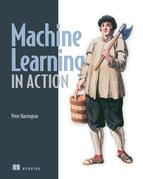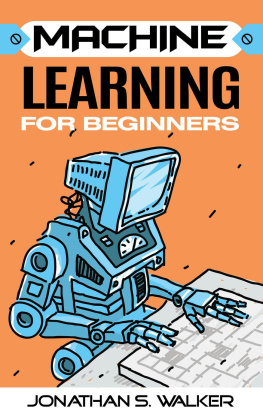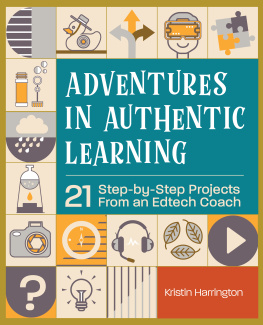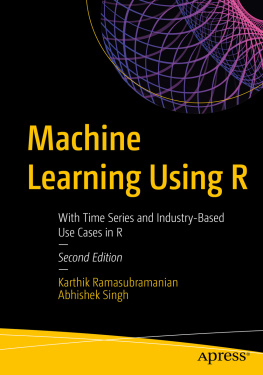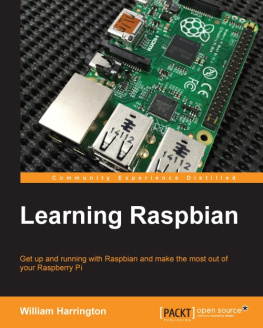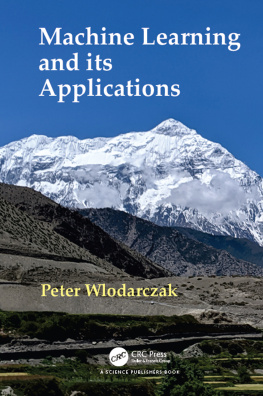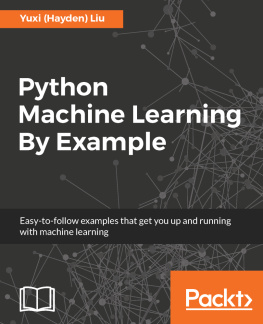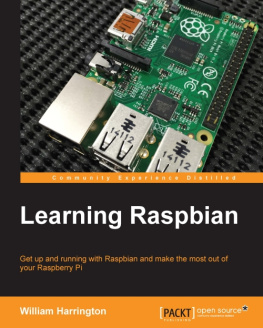Peter Harrington - Machine learning in action
Here you can read online Peter Harrington - Machine learning in action full text of the book (entire story) in english for free. Download pdf and epub, get meaning, cover and reviews about this ebook. City: Shelter Island, year: 2012, publisher: Manning Publications, genre: Home and family. Description of the work, (preface) as well as reviews are available. Best literature library LitArk.com created for fans of good reading and offers a wide selection of genres:
Romance novel
Science fiction
Adventure
Detective
Science
History
Home and family
Prose
Art
Politics
Computer
Non-fiction
Religion
Business
Children
Humor
Choose a favorite category and find really read worthwhile books. Enjoy immersion in the world of imagination, feel the emotions of the characters or learn something new for yourself, make an fascinating discovery.
- Book:Machine learning in action
- Author:
- Publisher:Manning Publications
- Genre:
- Year:2012
- City:Shelter Island
- Rating:5 / 5
- Favourites:Add to favourites
- Your mark:
- 100
- 1
- 2
- 3
- 4
- 5
Machine learning in action: summary, description and annotation
We offer to read an annotation, description, summary or preface (depends on what the author of the book "Machine learning in action" wrote himself). If you haven't found the necessary information about the book — write in the comments, we will try to find it.
Machine learning in action — read online for free the complete book (whole text) full work
Below is the text of the book, divided by pages. System saving the place of the last page read, allows you to conveniently read the book "Machine learning in action" online for free, without having to search again every time where you left off. Put a bookmark, and you can go to the page where you finished reading at any time.
Font size:
Interval:
Bookmark:

For online information and ordering of this and other Manning books, please visit www.manning.com. The publisher offers discounts on this book when ordered in quantity. For more information, please contact
Special Sales Department Manning Publications Co. 20 Baldwin Road PO Box 261 Shelter Island, NY 11964 Email: orders@manning.com2012 by Manning Publications Co. All rights reserved.
No part of this publication may be reproduced, stored in a retrieval system, or transmitted, in any form or by means electronic, mechanical, photocopying, or otherwise, without prior written permission of the publisher.
Many of the designations used by manufacturers and sellers to distinguish their products are claimed as trademarks. Where those designations appear in the book, and Manning Publications was aware of a trademark claim, the designations have been printed in initial caps or all caps.
 | Recognizing the importance of preserving what has been written, it is Mannings policy to have the books we publish printed on acid-free paper, and we exert our best efforts to that end. Recognizing also our responsibility to conserve the resources of our planet, Manning books are printed on paper that is at least 15 percent recycled and processed without the use of elemental chlorine. |
 | Manning Publications Co.20 Baldwin RoadPO Box 261Shelter Island, NY 11964 | Development editor:Jeff BleielTechnical proofreaders: Tricia Hoffman, Alex OttCopyeditor: Linda RecktenwaldProofreader: Maureen SpencerTypesetter: Gordan SalinovicCover designer: Marija Tudor |
Printed in the United States of America
1 2 3 4 5 6 7 8 9 10 MAL 17 16 15 14 13 12
To Joseph and Milo
After college I went to work for Intel in California and mainland China. Originally my plan was to go back to grad school after two years, but time flies when you are having fun, and two years turned into six. I realized I had to go back at that point, and I didnt want to do night school or online learning, I wanted to sit on campus and soak up everything a university has to offer. The best part of college is not the classes you take or research you do, but the peripheral things: meeting people, going to seminars, joining organizations, dropping in on classes, and learning what you dont know.
Sometime in 2008 I was helping set up for a career fair. I began to talk to someone from a large financial institution and they wanted me to interview for a position modeling credit risk (figuring out if someone is going to pay off their loans or not). They asked me how much stochastic calculus I knew. At the time, I wasnt sure I knew what the word stochastic meant. They were hiring for a geographic location my body couldnt tolerate, so I decided not to pursue it any further. But this stochastic stuff interested me, so I went to the course catalog and looked for any class being offered with the word stochastic in its title. The class I found was Discrete-time Stochastic Systems. I started attending the class without registering, doing the homework and taking tests. Eventually I was noticed by the professor and she was kind enough to let me continue, for which I am very grateful. This class was the first time I saw probability applied to an algorithm. I had seen algorithms take an averaged value as input before, but this was different: the variance and mean were internal values in these algorithms. The course was about time series data where every piece of data is a regularly spaced sample. I found another course with Machine Learning in the title. In this class the data was not assumed to be uniformly spaced in time, and they covered more algorithms but with less rigor. I later realized that similar methods were also being taught in the economics, electrical engineering, and computer science departments.
In early 2009, I graduated and moved to Silicon Valley to start work as a software consultant. Over the next two years, I worked with eight companies on a very wide range of technologies and saw two trends emerge which make up the major thesis for this book: first, in order to develop a compelling application you need to do more than just connect data sources; and second, employers want people who understand theory and can also program.
A large portion of a programmers job can be compared to the concept of connecting pipesexcept that instead of pipes, programmers connect the flow of dataand monstrous fortunes have been made doing exactly that. Let me give you an example. You could make an application that sells things onlinethe big picture for this would be allowing people a way to post things and to view what others have posted. To do this you could create a web form that allows users to enter data about what they are selling and then this data would be shipped off to a data store. In order for other users to see what a user is selling, you would have to ship the data out of the data store and display it appropriately. Im sure people will continue to make money this way; however to make the application really good you need to add a level of intelligence. This intelligence could do things like automatically remove inappropriate postings, detect fraudulent transactions, direct users to things they might like, and forecast site traffic. To accomplish these objectives, you would need to apply machine learning. The end user would not know that there is magic going on behind the scenes; to them your application just works, which is the hallmark of a well-built product.
An organization may choose to hire a group of theoretical people, or thinkers, and a set of practical people, doers. The thinkers may have spent a lot of time in academia, and their day-to-day job may be pulling ideas from papers and modeling them with very high-level tools or mathematics. The doers interface with the real world by writing the code and dealing with the imperfections of a non-ideal world, such as machines that break down or noisy data. Separating thinkers from doers is a bad idea and successful organizations realize this. (One of the tenets of lean manufacturing is for the thinkers to get their hands dirty with actual doing.) When there is a limited amount of money to be spent on hiring, who will get hired more readilythe thinker or the doer? Probably the doer, but in reality employers want both. Things need to get built, but when applications call for more demanding algorithms it is useful to have someone who can read papers, pull out the idea, implement it in real code, and iterate.
I didnt see a book that addressed the problem of bridging the gap between thinkers and doers in the context of machine learning algorithms. The goal of this book is to fill that void, and, along the way, to introduce uses of machine learning algorithms so that the reader can build better applications.
This is by far the easiest part of the book to write...
First, I would like to thank the folks at Manning. Above all, I would like to thank my editor Troy Mott; if not for his support and enthusiasm, this book never would have happened. I would also like to thank Maureen Spencer who helped polish my prose in the final manuscript; she was a pleasure to work with.
Next I would like to thank Jennie Si at Arizona State University for letting me sneak into her class on discrete-time stochastic systems without registering. Also Cynthia Rudin at MIT for pointing me to the paper Top 10 Algorithms in Data Mining,[] which inspired the approach I took in this book. For indirect contributions I would like to thank Mark Bauer, Jerry Barkely, Jose Zero, Doug Chang, Wayne Carter, and Tyler Neylon.
Font size:
Interval:
Bookmark:
Similar books «Machine learning in action»
Look at similar books to Machine learning in action. We have selected literature similar in name and meaning in the hope of providing readers with more options to find new, interesting, not yet read works.
Discussion, reviews of the book Machine learning in action and just readers' own opinions. Leave your comments, write what you think about the work, its meaning or the main characters. Specify what exactly you liked and what you didn't like, and why you think so.

